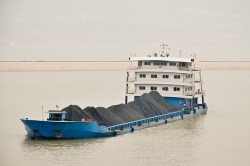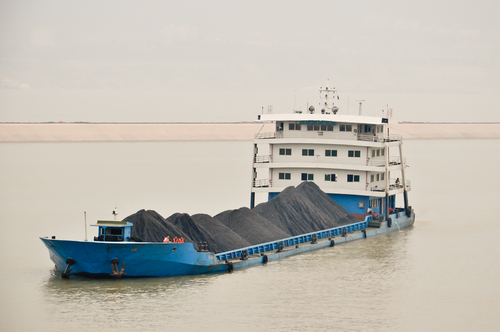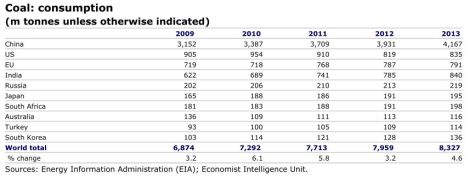
ShutterstockCoal on the move.
Last week, I wrote that the U.S. coal industry is in trouble and the only way it can hope to reverse its downward slide is through increased exports, mostly to China. This isn’t a crazy notion: Coal consumption has been rising and will continue to rise in China, in absolute terms. But there’s reason to think the rate of growth may be slower than expected, and consequently that exports may not be the sure thing U.S. coal companies need.
The same discussion is happening in Australia: Coal companies are eager to build giant new coal mines in Queensland and they’re using projected Asian demand to justify them. Noted Australian economist Ross Garnaut, adviser to the Labor government and author of the famed (in some circles) Garnaut Climate Change Review, recently downplayed Chinese demand:
Professor Garnaut told the conference the “awful reality” was that “parts of corporate Australia had dissipated shareholders’ funds by underestimating the seriousness of Chinese commitments to reduce the emissions intensity of economic growth”. This had led to “wasteful over-investment in thermal coal mining and exporting capacity”.
Professor Garnaut said coal-fired electricity production [in China] in August was more than 7 per cent lower than in August 2011. “Coal’s share of energy production was down from 85 per cent in February to 73 per cent in August,” he said. …
Non-fossil fuels sources accounted for a record 27 per cent of China’s electricity production in August as renewables soared.
Despite China’s slowing economy, electricity production has risen 15 per cent this year. But the growth has been in renewables.
“In China,” Garnaut summarized in an interview with the Australian Financial Review, “thermal [coal] is in deep shit.”
(Thermal coal, for the non-nerds, is coal used for electricity generation — as opposed to metallurgical coal, used for steelmaking.)
The picture painted by the Economist Intelligence Unit’s “monthly coal outlook” isn’t quit as grim, but it contains strong notes of caution:
Recent indicators suggest China’s demand could slow faster than expected
Developments in China, which accounted for nearly 50% of global coal consumption in 2011, will remain central to global coal demand in 2012-13. China relies on coal for more than 80% of its power generation. The country became a net importer of thermal coal in 2007 and the world’s largest importer in 2011. According to China’s National Bureau of Statistics, coal demand grew by 9.7% in 2011 as a whole, as the economy continued to expand rapidly.
However, an economic slowdown is now under way, prompted by Europe’s troubles and the authorities’ moves to engineer a soft landing. The Chinese government has downgraded its medium-term GDP growth target to 7.5% and is attempting to shift economic growth away from capital investment and exports towards domestic consumption. This will affect demand for many commodities, including thermal coal, which will in turn be affected by slower growth in electricity generation and weaker demand from the building materials industry. Our baseline forecast continues to envisage a less rapid economic slowdown than the official target, with growth picking up in the second half of 2012 after a weak start to the year.
Efforts to curtail emissions are also likely to constrain coal consumption. The central authorities are, according to some reports, firming up plans that they have been working on for a while to cap total energy consumption in the country by 2015—reportedly at 4.2bn tonnes of coal equivalent (a 4.1bn-tonne cap had previously been mooted). This would imply average annual growth of around 5% in 2012-15 (total energy consumption rose by 7% in 2011). The central authorities have reportedly reached agreement with provincial authorities on targets for individual cities and provinces. However, there are doubts as to the feasibility of the plans. In general, ongoing expansion in coal-fired power-generating capacity and a still-solid pace of economic growth mean that growth in demand for coal will still notch up an annual average rate of 6% in 2012-13, according to our forecasts.
At least in the short term, there appears to be a global oversupply of thermal coal.
This Sierra Club report [PDF] goes into more detail on the dangers facing coal investments. One of the trends it highlights is the rising price of internationally traded coal, mainly due to the rise in the price of oil. (Remember, coal has to be transported to export terminals, shipped overseas, and transported to coal plants — that takes lots of oil, mainly in the form of diesel fuel.) The more expensive U.S. coal ends up being when it reaches Chinese shores, the less they’ll buy.
None of this is to downplay the rising global tide of coal. As Gregor MacDonald reminds us, it is the “ignored juggernaut” of world energy. Coal consumption is rising in virtually every major country except the U.S. and Australia:
Nonetheless, there are at least glimmers of hope that the rise of coal in China is not as inexorable as typically believed. If it isn’t, it’s bad news for the U.S. coal industry, but good news for future generations.




